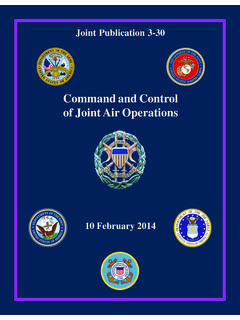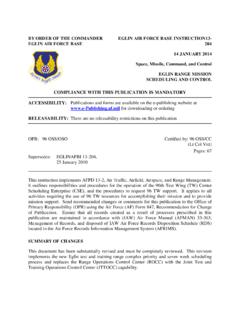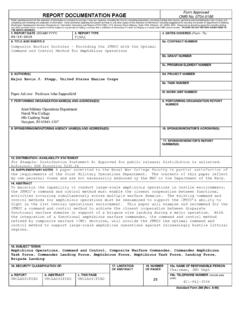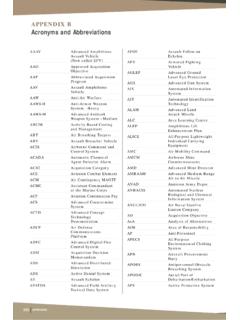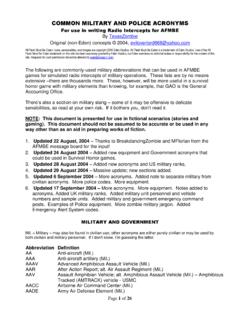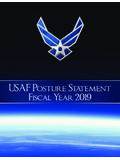Transcription of NAVAL POSTGRADUATE SCHOOL
1 NAVAL POSTGRADUATE SCHOOL MONTEREY, CALIFORNIA MBA PROFESSIONAL REPORT Force XXI Battle command Brigade and Below-Blue Force Tracking (FBCB2-BFT). A Case Study in the Accelerated Acquisition of a Digital command and Control System during Operations Enduring Freedom and Iraqi Freedom By: James L. Conatser Vincent E. Grizio December 2005 Advisors: Michael W. Boudreau, Pete Coughlan Approved for public release; distribution is unlimited. THIS PAGE INTENTIONALLY LEFT BLANK i REPORT DOCUMENTATION PAGE Form Approved OMB No. 0704-0188 Public reporting burden for this collection of information is estimated to average 1 hour per response, including the time for reviewing instruction, searching existing data sources, gathering and maintaining the data needed, and completing and reviewing the collection of information.
2 Send comments regarding this burden estimate or any other aspect of this collection of information, including suggestions for reducing this burden, to Washington headquarters Services, Directorate for Information Operations and Reports, 1215 Jefferson Davis Highway, Suite 1204, Arlington, VA 22202-4302, and to the Office of Management and Budget, Paperwork Reduction Project (0704-0188) Washington DC 20503. 1. AGENCY USE ONLY (Leave blank) 2. REPORT DATE December 2005 3. REPORT TYPE AND DATES COVERED MBA Professional Report 4. TITLE AND SUBTITLE: Force XXI Battle command Brigade and Below-Blue Force Tracking (FBCB2-BFT). A Case Study in the Accelerated Acquisition of a Digital command and Control System during Operations Enduring Freedom and Iraqi Freedom 6. AUTHOR(S) James L. Conatser Vincent E. Grizio 5. FUNDING NUMBERS 7. PERFORMING ORGANIZATION NAME(S) AND ADDRESS(ES) NAVAL POSTGRADUATE SCHOOL Monterey, CA 93943-5000 8. PERFORMING ORGANIZATION REPORT NUMBER 9.
3 SPONSORING / MONITORING AGENCY NAME(S) AND ADDRESS(ES) 10. SPONSORING / MONITORING AGENCY REPORT NUMBER 11. SUPPLEMENTARY NOTES The views expressed in this report are those of the author(s) and do not reflect the official policy or position of the Department of Defense or the Government. 12a. DISTRIBUTION / AVAILABILITY STATEMENT Approved for public release; distribution is unlimited 12b. DISTRIBUTION CODE 13. ABSTRACT (maximum 200 words) The purpose of this project is to provide a process for accelerated acquisition in support of contingency operations. The objective of the project is to recreate and document the events surrounding the fielding of FBCB2-BFT during Operations Enduring and Iraqi Freedom, and to produce a document that provides an analysis of actions taken, the obstacles that were overcome and the acquisition policy that applied to the situation in order to rapidly acquire, produce, train and field a useful solution to fulfill an urgent and valid operational need.
4 In 2002, while conducting the Global War on Terror, the US Army determined that combat on an asymmetric battlefield, consisting of a complex operational environment as well as an increased geographic battlespace, required improvements to the current command and control capability available to the force. PM FBCB2 determined their system could fulfill the need by taking the current FBCB2 system and adjusting it to meet the new operational need. Given the constraints regarding time, funding, and technical feasibility PM FBCB2 diligently worked with multiple organizations and agencies in order to provide a useful solution for friendly forces in Operations Enduring Freedom and Iraqi Freedom. In the 12 months prior to 21 March 2003 (G-Day Iraqi Freedom), the Army undertook an enormous effort to develop, produce, provide system training, and field FBCB2-BFT. The FBCB2-BFT initiative was successful due to the synchronization of four interrelated and supporting components; 1) a technically mature system, 2) user representative acceptance, 3) senior leadership support, and 4) a funding stream.
5 15. NUMBER OF PAGES 73 14. SUBJECT TERMS Situational Awareness, Situational Dominance, Situational Understanding, Common Relevant Operational Picture, Digitization 16. PRICE CODE 17. SECURITY CLASSIFICATION OF REPORT Unclassified 18. SECURITY CLASSIFICATION OF THIS PAGE Unclassified 19. SECURITY CLASSIFICATION OF ABSTRACT Unclassified 20. LIMITATION OF ABSTRACT UL ii THIS PAGE INTENTIONALLY LEFT BLANK iiiApproved for public release; Distribution is unlimited FORCE XXI BATTLE command BRIGADE AND BELOW-BLUE FORCE TRACKING (FBCB2-BFT). A CASE STUDY IN THE ACCELERATED ACQUISITION OF A DIGITAL command AND CONTROL SYSTEM DURING OPERATIONS ENDURING FREEDOM AND IRAQI FREEDOM James L. Conatser, Major, Army Vincent E. Grizio, Major, Army Submitted in partial fulfillment of the requirements for the degree of MASTER OF BUSINESS ADMINISTRATION from the NAVAL POSTGRADUATE SCHOOL December 2005 Authors: _____ James L. Conatser _____ Vincent E.
6 Grizio Approved by: _____ Michael W. Boudreau Lead Advisor _____ Pete Coughlan Support Advisor _____ Robert Beck, Dean Graduate SCHOOL of Business and Public Policy iv THIS PAGE INTENTIONALLY LEFT BLANK vFORCE XXI BATTLE command BRIGADE AND BELOW-BLUE FORCE TRACKING (FBCB2-BFT). A CASE STUDY IN THE ACCELERATED ACQUISITION OF A DIGITAL command AND CONTROL SYSTEM DURING OPERATIONS ENDURING FREEDOM AND IRAQI FREEDOM ABSTRACT The purpose of this project is to provide a process for accelerated acquisition in support of contingency operations. The objective of the project is to recreate and document the events surrounding the fielding of FBCB2-BFT during Operations Enduring and Iraqi Freedom, and to produce a document that provides an analysis of actions taken, the obstacles that were overcome and the acquisition policy that applied to the situation in order to rapidly acquire, produce, train and field a useful solution to fulfill an urgent and valid operational need.
7 In 2002, while conducting the Global War on Terror, the US Army determined that combat on an asymmetric battlefield, consisting of a complex operational environment as well as an increased geographic battlespace, required improvements to the current command and control capability available to the force. PM FBCB2 determined their system could fulfill the need by taking the current FBCB2 system and adjusting it to meet the new operational need. Given the constraints regarding time, funding, and technical feasibility PM FBCB2 diligently worked with multiple organizations and agencies in order to provide a useful solution for friendly forces in Operations Enduring Freedom and Iraqi Freedom. In the 12 months prior to 21 March 2003 (G-Day Iraqi Freedom), the Army undertook an enormous effort to develop, produce, provide system training, and field FBCB2-BFT. The FBCB2-BFT initiative was successful due to the synchronization of four interrelated and supporting components; 1) a technically mature system, 2) user representative acceptance, 3) senior leadership support, and 4) a funding stream.
8 Vi THIS PAGE INTENTIONALLY LEFT BLANK viiTABLE OF CONTENTS I. A. PROBLEM STATEMENT ..1 B. THE PURSUIT OF INFORMATION II. BACKGROUND ..5 A. THE UNITED STATES ARMY IN TRANSITION ..5 B. THE EVOLUTION OF FORCE 1. Advanced Warfighting Experiment I ..7 2. Task Force XXI ..8 3. Army Battle command System ..9 a. Global command and Control System-Army (GCSS-A)..9 b. Force XXI Battle command Brigade-and-Below (FBCB2) ..9 c. Advanced Field Artillery Tactical Data System (AFATDS)..10 d. Air and Missile Defense Workstation (AMDWS) ..10 e. All Source Analysis System (ASAS) ..10 f. Battle command Sustainment Support System (BCS3) ..10 g. Combat Terrain Information System (CTIS)..10 h. Tactical Airspace Integration System (TAIS) ..10 i. Maneuver Control System (MCS) ..10 j. Integrated Meteorological System (IMETS) ..11 k. Integrated System Control (ISYSCON)..11 l. ABCS Information Server (AIS) ..11 4. Advanced Warfighting Experiment II.
9 12 5. Division Advanced Warfighting Experiment ..16 6. Division Capstone Exercise ..19 C. THE BALKAN DIGITIZATION INITIATIVE ..27 III. EXPLOITING THE POTENTIAL ..33 A. 1. Information Management Task Force (IMTF) ..33 a. Phase b. Phase Two ..34 c. Phase d. Mission 2. FBCB2-EPLRS and FBCB2-BFT Differences ..39 B. RESULTS ..41 C. THE FUTURE OF FBCB2-EPLRS AND IV. FBCB2-BFT CONTINGENCY FIELDING A. TECHNICAL MATURITY ..50 B. USER ACCEPTANCE ..51 C. MILITARY LEADERSHIP SUPPORT ..52 viiiD. FUNDING BIBLIOGRAPHY ..55 INITIAL DISTRIBUTION LIST ..57 ixLIST OF FIGURES Figure 1. The Principle Components of Rapid Acquisition in Support of Contingency Figure 2. Three Distinct Domains Chart (After: Understanding Information Age Warfare p. 40.) ..4 Figure 3. The Army Battle command System Network (After: (November 3, 2005)) ..12 Figure 4. FBCB2 Program Figure 5. Evolution of FBCB2 Hardware (After: Artillery Symposium Briefing (2003)).
10 23 Figure 6. Terrestrial Based FBCB2 Figure 7. FBCB2 EPLRS Based Architecture (After: FBCB2 Training Support Material (2005)) ..25 Figure 8. FBCB2 Soldier Interface (After: TSM XXI Army Knowledge Symposium Briefing (2003)) ..26 Figure 9. Balkan Digitization Initiative Architecture (After: TSM XXI Army Knowledge Symposium (2003)) ..30 Figure 10. Balkan Digitization Initiative Components (After: TSM XXI Army Knowledge Symposium (2003)) ..31 Figure 11. FBCB2-BFT Architecture (After: TSM XXI Army Knowledge Symposium (2003)) ..46 Figure 12. FBCB2-BFT Components (After: TSM XXI Army Knowledge Symposium (2003)) ..47 Figure 13. FBCB2-BFT Installation Variants (After: TSM XXI Army Knowledge Symposium (2003)) ..48 Figure 14. The Principle Components of Rapid Acquisition in Support of Contingency x THIS PAGE INTENTIONALLY LEFT BLANK xiLIST OF ABBREVIATIONS, ACRONYMS.










